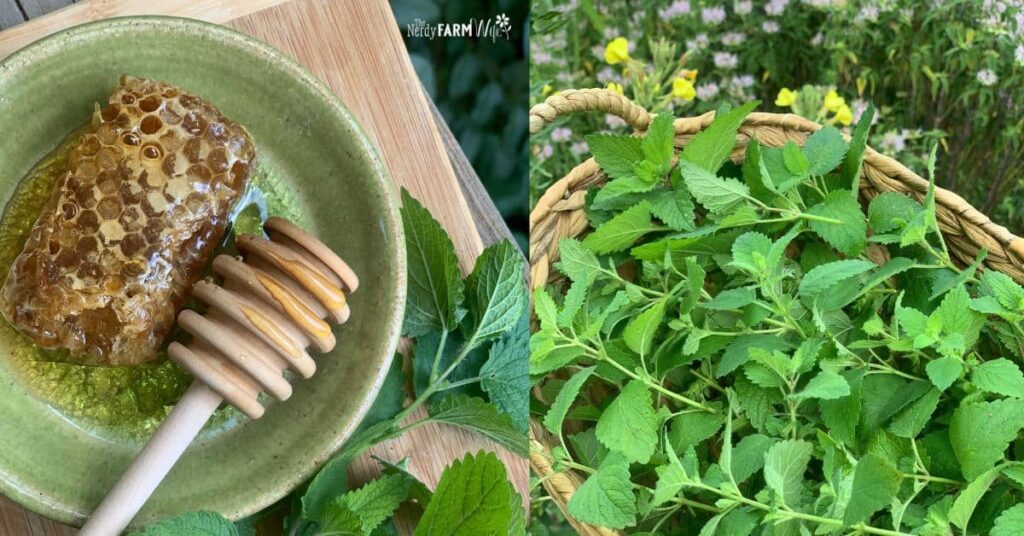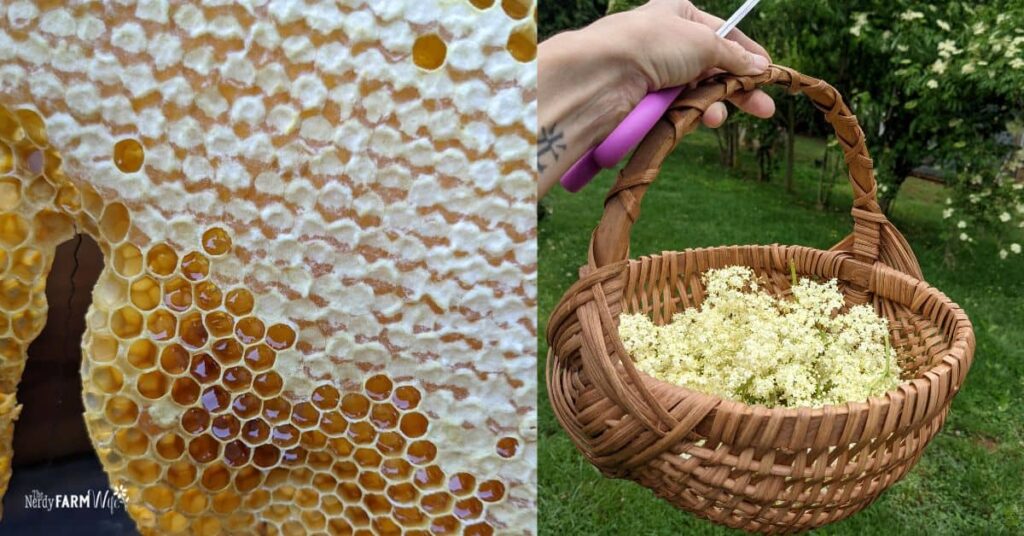How to Make Herbal Honey Syrups
Honey syrups are a simple and sweet way to take your herbal remedies!
They’re especially helpful for the sore throats and coughs of winter, but can be used year ’round.
If you can simmer a pot of water, you can make an herbal syrup. It’s super easy!


Basic Formulas for Making Herbal Honey Syrups
In essence, a honey herbal syrup is 1 part strong herbal tea mixed together with 2 parts of honey. (A 1:2 ratio of tea to honey.)
Examples: If you had 1/4 cup of tea, you would use 1/2 cup of honey to turn it into a syrup. Or, for 1 cup of tea, you would use 2 cups of honey to make a syrup.
Alternatively, I’ve also made plenty of syrups with 1 part tea to 1 part honey (1:1 ratio), but those are more watered down, and have a shorter shelf life of a few weeks, unless you add about 15 to 20% brandy to them as a preservative.
In order to make a syrup, you’ll first need to make an herbal tea.

To make a strong tea with leaves & flowers:
Making a simple tea can be as easy as taking a generous handful of chopped fresh herbal leaves or flowers, or a couple of tablespoons of dried herbs, putting them in a heatproof mug, pouring simmering water over them, covering the top with a saucer, then steeping for an hour or longer, until cooled.
The longer you steep, the stronger the tea will be. If you’re steeping tea over 2 hours though, move it to the fridge to keep it food-safe.
Cold Infusions
A few herbs, such as sweet violet and marshmallow, have beneficial compounds that are best infused in cold water, rather than hot. In this case, you can soak the herb in cold water in your fridge overnight, then gently heat in a saucepan, but not quite hot enough for a simmer. Heat uncovered for about 15 to 30 minutes, then turn off the burner. Cover the pot and let the herb/leaves steep for another 20 minutes or so. Strain and make your syrup.

Or, to make tea with berries, roots, and twigs:
Things like dried berries, roots, and twigs will need to be soaked and simmered in water since they’re thicker/tougher and it takes a little more time and added heat to get those beneficial compounds into the water, compared to more delicate leaf and flower herbs. (Simmering herbs in water is called making a decoction, but you’re still basically making a tea.)
If possible, it helps to soak dried twigs, berries, and roots in the saucepan of water for at least an hour or two before simmering, then turn on the heat and gently simmer, uncovered, for about 15 to 30 minutes. Simmering longer will make more water evaporate and the tea (decoction) stronger.

To make the syrup:
Combine 1 part of strained tea with 2 parts honey in a saucepan.
Heat the mixture very gently, to help the honey mix into the herbal tea, but don’t let it simmer or the temperature go over 110 degrees F, because we want to keep those wonderful benefits of raw honey.
Remove from heat.
(If you’re making a syrup with 1 part tea to 1 part honey, consider adding 15 to 20% brandy for longer shelf life at this point.)
Pour the syrup into a scrupulously clean canning jar (I run my jars through the sanitize cycle of my dishwasher, or you can submerge it in a pot of water and boil for 10 minutes.)
Using a damp cloth, wipe the rims clean of any sticky honey residue, then let the syrup cool before covering with a top.
Remember that honey should not be given to children under the age of 1, because honey can contain a bacteria (Clostridium botulinum) that an infant’s immature digestive system can’t fight off.

Ideas for Herbs to Use
Here are some herbs to think about trying in your herbal syrups. If you enjoy drinking an herb internally as a tea, it’s likely a good candidate for a syrup!
Before you buy a lot of separate ingredients, keep in mind that you can always use pre-made purchased teas to make syrups. For an amazing selection of high quality teas, check out Farmhouse Teas.
They have a ready-to-make Herbal Elderberry Syrup Mix and also a Wild Cherry Bark Syrup Kit.
Their popular 3 pack sampler set is an excellent way to try out teas that catch your fancy. (I’ve also given this as a Christmas gift before; it arrived beautifully packaged and the recipient loved it!)
Feel free to get creative and experiment with combining herbs and spices from your garden and/or spice cabinet!
Here’s an example of a Ginger & Lemon Balm Honey Syrup I make for cold and flu season, which combines fresh ginger from the grocery store with fresh lemon balm leaves from my garden. (Or you could use half as much dried ingredients.)
- Astragalus Root (Astragalus membranaceus) – one of my personal favorite herbs, it’s used to increase energy, protect the liver, and modulates the immune system, among other things. This herb needs simmering. Add a few broken bits of root to your herbal mix for an immunity boost.
- Violet Leaves (Viola odorata, V. sororia) – use the cold infusion method to make the strong tea; useful for sore throat, coughs, dry and irritated tissues, and is specifically used as an anti-cancer for mouth and throat. I recommend foraging your own violets while they’re in bloom; they’re easy to grow too!
- Elderberries (Sambucus nigra) – elderberry syrup is a classic for fighting off colds and flu! I have a 1:1 recipe for Elderberry Syrup on this site, but you could easily double the honey amount for longer shelf life.
- Lemon Balm (Melissa officinalis) – this makes a wonderful syrup for anxiety, stress, insomnia, cold sores, viruses, and/or stomach ache. You can find my Sleepy Time Syrup recipe in my article, 12+ Things to Do with Lemon Balm (again, double the honey amount for longer shelf life).
- Wild Cherry Bark (Prunus serotina) – for coughs and sore throats, needs simmering
- Rosehips (Rosa spp) – high in flavonoids and vitamin C
- Ginger (Zingiber officinale) – antiviral, anti-inflammatory, helps stomach ache and nausea, warming, adds flavor
- Cinnamon Sticks (Cinnamomum verum) – makes the syrup more warming, adds flavor, stimulates circulation
- Elder Flowers (Sambucus spp) – antiviral, for colds, fevers, sore throat
- Hawthorn Berries (Crataegus monogyna) – a gentle tonic herb for the heart and circulatory system
- Self Heal (Prunella vulgaris) – also called “heal all”, useful for cold sores and sore throats
- Thyme (Thymus vulgaris) – for coughs, bronchitis (medicinal amounts are not recommended for pregnant women)
There are even more herbs that can do well in herbal syrups, so don’t feel limited by this short list!
Just remember, if you can’t drink a flower or herb as a tea, it’s likely not a good choice for a syrup. (For example – we only use comfrey externally, so I wouldn’t use it for a tea or a syrup.)
Shelf Life & Storage
Store your 1:2 herbal syrups in the refrigerator for several months. Some herbalists keep them a full year, but keep a close eye on them and discard if any mold is noted.
Herbal syrups made with a 1:1 ratio of tea and honey can be stored in the fridge for several weeks.
To help your finished honey syrups have a longer shelf life, optionally add about 15 to 20% brandy.
Example amount: For 1 cup (8 ounces) of finished syrup, add about 1.5 ounces of brandy.
To get that amount, I just asked google: What is 15% of 8? And the answer was 1.2, which I rounded up to 1.5 ounces for ease of measuring.
How to Use
Take by the spoonful as needed!
A good starting point is 1 to 2 teaspoons, several times per day.
You can also use herbal syrups to sweeten teas, drizzle over foods, or mix into beverages.
Remember that honey should never be given to babies under 1 year old.



Jan, thank you so much for sharing all of this information. Greatly appreciate it!!
So happy to hear you enjoyed the article! :)
I noticed a correction needs to be made on the math in the ‘Shelf Life & Storage’ section.
“Example amount: For 1 cup (16 ounces) of finished syrup, add about 2.5 ounces of brandy.
To get that amount, I just asked google: What is 15% of 16? And the answer was 2.4, which I rounded up to 2.5 for ease of measuring.”
Correction: 1 cup is not 16 ounces; it’s 8 ounces. So 15% of 8 is 1.2 ounces.
Hi Christine, Thank You! I completely missed that typo & the resulting mis-math!
I just fixed it up.
I really appreciate you letting me know!